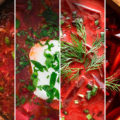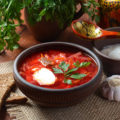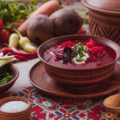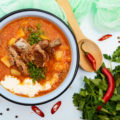Borscht is considered a national dish in Russia, Ukraine, Belarus, Poland, Romania, Moldova, and Lithuania. However, not everyone is ready to acknowledge it as the common heritage of the Slavic and Baltic peoples.
Sometimes, the argument on the “nationality” of borscht gets the more violent, the more complicated geopolitics becomes. Still, this is not the case when truth is born in dispute, because it is absolutely impossible to identify the original recipe for borscht.
“The basic recipe, protoborsch, so to speak, was very simple,” says M. Marusenkov, a food historian, candidate of philological sciences. “People in any region where beetroots grow would have figured out how to cook such a stew. In the Little Russian and southwestern provinces, borscht became mass and common, while in other regions it remained a dish of the manorial and city cuisine for a long time. This is where the false idea of the Little Russian origin of borscht comes from. In fact, this is just a regional variety of a Russian or, if you like, an all-Russian dish.”
Gdansk merchant Martin Gruneweg left an interesting comment in “The Notes on a Trading Trip to Moscow in 1584–1585”. Once in Kiev, he mentioned the specifics of the local cuisine: “Russians rarely or never buy borscht, because everyone cooks it at home, since it is their daily food and drink.”
Now and then, borscht is mentioned on the pages of Russian classics. Anton Chekhov in the story “My Life” writes, “Except in Lent all the houses smelt of bortsch, and during Lent of sturgeon fried in sunflower oil.” In Nikolai Gogol’s “The Tale of How Ivan Ivanovich Quarreled with Ivan Nikiforovich”, the character “gets into a terrible rage if a fly falls into his beet soup. Then he is fairly beside himself, he flings away his plate and the housekeeper catches it.”
Borscht has become so deeply embedded in Russian culture that at the beginning of the space age, Russian cosmonauts even took it into orbit. To cook space borscht, one needs not only a pot, but also a freeze dryer. When borsch is ready, it is poured onto a baking sheet and sent to a chamber with a temperature of 30–50 centigrade below zero. Then borscht is put in vacuum, while the heating is turned on. As a result, liquid borscht turns into a pinkish-red powder.
Obviously, although borscht is an international dish, it was cooked in its own way in each region. Still, borscht is borscht, no matter where it is made, and its recipes in various countries have more similarities than differences. After all, a pot of rich soup has always been an occasion to gather a large company at the table without quarrels and arguments.
Tatiana Borisova
Moscow borscht
Recipe by chef Vasily Emelianenko
The chef uses beetroot broth for richer color and flavor.
Put the meat in 3 liters of water, add carrots and onions, and cook for an hour, removing the foam.
Wash the beetroots properly and peel them. Put the peels in a saucepan filled with water, add salt, vinegar, and cook for 20 minutes.
Cut cabbage, carrots, onions, and beetroots into strips, and dice potatoes. Sauté the beetroots in oil for 15 minutes, stirring occasionally. Add carrots and onions and sauté them for 10 minutes more. Add tomato paste, salt, and sugar to the vegetables, stir, and sauté for some more time.
Take the meat out of the broth, put cabbage and potatoes into the pot, and cook for 15 minutes. Add the sautéd vegetables and beetroot broth and simmer it for a while. Before serving, put the chopped meat into a plate.
Ingredients: 1 kg meat on the bone, 400 g beetroots, 400 g cabbage, 300 g potatoes, 2 carrots, 2 onions, 4 l water, 70 g tomato paste, 15–20 ml vegetable oil, 25 g salt, 30 g vinegar, 50 g sugar.
Belarusian borscht
Recipe by chef Sergei Rechkalov
Cooked without cabbage, but with beetroot kvass.
Make beetroot kvass 3 or 4 days in advance: coarsely grate peeled beetroots, add sugar to taste, add cold boiled water, and leave it to brew in a warm place.
Put beef ribs or brisket into the water and start cooking it. Boil the beetroots in another pot.
Peel and cut carrots, onions, and potatoes. Heat finely chopped lard in a frying pan. Sauté the onion, then add the carrots and two tablespoons of tomato paste.
Take the cooked beetroots out of the pot. Peel and cut them into strips. Put the beetroots into the saucepan, add beetroot kvass, and simmer.
Put the potatoes into the meat broth and add the sautéd onions, carrots, and tomatoes.
Dilute a spoonful of flour in water and add it to the borscht to make it thicker. Take the beetroots from the saucepan into the pot and boil the borscht for a while. Add salt, sugar, and vinegar to taste.
Ingredients: 1 kg beef ribs or brisket, 1 beetroot, 2 carrots, 2 potatoes, 1 onion, 1 tbsp tomato paste, 30 g lard, 1 tbsp sugar, 2 tbsp vinegar, 1 tbsp flour, 100 ml beetroot kvass, salt, water.
Polish borscht
Recipe by chef Alexander Belkovich
In this recipe, sour cream is added at the cooking stage, and potatoes are served as a side dish instead of bread.
Cook the pork ribs to make the broth. Grate the beetroots on a coarse grater and sauté them in vegetable oil. Then add water and simmer the beetroots until tender. Add vinegar and simmer for another 15 minutes. Cut the onion into strips and sauté until golden brown. Add chopped garlic, tomato paste, and a little broth to the pan, and continue to sauté.
Take the meat out of the broth. Put the sautéd vegetables and beetroots into the broth. Remove the meat from the ribs and put it back into the pot.
Mix sour cream, a spoonful of water, and a spoonful of flour in a separate bowl and add this mixture to the borscht. Season it with salt and pepper. Let it boil for another 5 minutes. Before serving, decorate a plate of borscht with boiled egg quarters and sprinkle with herbs. Serve the borscht with boiled potatoes instead of bread.
Ingredients: 500 g pork ribs, 5 beetroots, 2 tbsp vinegar, 6–7 cloves of garlic, 2 tbsp tomato paste, 300 g sour cream 20%, 2 tbsp flour, 6 eggs, 750 g potatoes.
Ukrainian borscht
Recipe by chef Elena Nikiforova
The recipe combines meat and beans, and lard is used to enhance the taste of the dish. Put the meat into cold water, bring to a boil, remove the foam, reduce the heat, and cook for about 40 minutes. Coarsely chop an onion and carrots, fry them in a dry frying pan, put into the broth, and cook for about 2.5 hours.
Rinse the beans, boil them in another pot until half cooked. Cut the beets into strips and sauté with tomato paste until soft. If necessary, dilute the paste with the broth.
When the meat is cooked, take it out of the pot, discard any bones and cut into small pieces. Put the meat back to the pot 5 minutes before the borscht is ready.
Put the diced potatoes into the cooked broth and boil until half cooked. Drain the beans in a colander, let the water go, then add to the borscht and bring to a boil. Then put the shred cabbage and finely chopped sautéd onions and carrots. When the potatoes in the broth are cooked, add the sautéd beetroots to the borscht. Let the soup simmer for another 5 minutes.
Grind the unsalted lard and garlic in a meat grinder, add it to the boiling borscht, and immediately remove from the heat.
Ingredients: 700 g beef brisket, 2 onions, 2 carrots, 1900 g potatoes, 900 g white cabbage, 200 g giant white beans, 2100 g beetroots, 170 g lard, 30 g garlic, 500 g tomato paste, 50 g garlic sauce.





